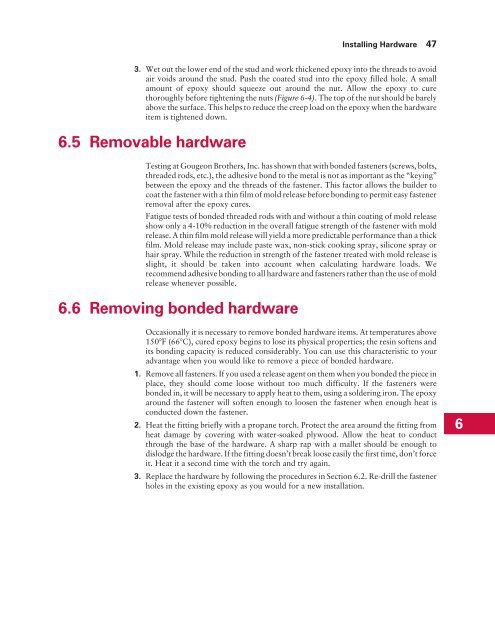Wooden Boat Restoration Repair - WEST SYSTEM Epoxy
Wooden Boat Restoration Repair - WEST SYSTEM Epoxy
Wooden Boat Restoration Repair - WEST SYSTEM Epoxy
Create successful ePaper yourself
Turn your PDF publications into a flip-book with our unique Google optimized e-Paper software.
3. Wet out the lower end of the stud and work thickened epoxy into the threads to avoid<br />
air voids around the stud. Push the coated stud into the epoxy filled hole. A small<br />
amount of epoxy should squeeze out around the nut. Allow the epoxy to cure<br />
thoroughly before tightening the nuts (Figure 6-4). The top of the nut should be barely<br />
above the surface. This helps to reduce the creep load on the epoxy when the hardware<br />
item is tightened down.<br />
6.5 Removable hardware<br />
Testing at Gougeon Brothers, Inc. has shown that with bonded fasteners (screws, bolts,<br />
threaded rods, etc.), the adhesive bond to the metal is not as important as the “keying”<br />
between the epoxy and the threads of the fastener. This factor allows the builder to<br />
coat the fastener with a thin film of mold release before bonding to permit easy fastener<br />
removal after the epoxy cures.<br />
Fatigue tests of bonded threaded rods with and without a thin coating of mold release<br />
show only a 4-10% reduction in the overall fatigue strength of the fastener with mold<br />
release. A thin film mold release will yield a more predictable performance than a thick<br />
film. Mold release may include paste wax, non-stick cooking spray, silicone spray or<br />
hair spray. While the reduction in strength of the fastener treated with mold release is<br />
slight, it should be taken into account when calculating hardware loads. We<br />
recommend adhesive bonding to all hardware and fasteners rather than the use of mold<br />
release whenever possible.<br />
6.6 Removing bonded hardware<br />
Installing Hardware 47<br />
Occasionally it is necessary to remove bonded hardware items. At temperatures above<br />
150°F (66°C), cured epoxy begins to lose its physical properties; the resin softens and<br />
its bonding capacity is reduced considerably. You can use this characteristic to your<br />
advantage when you would like to remove a piece of bonded hardware.<br />
1. Remove all fasteners. If you used a release agent on them when you bonded the piece in<br />
place, they should come loose without too much difficulty. If the fasteners were<br />
bonded in, it will be necessary to apply heat to them, using a soldering iron. The epoxy<br />
around the fastener will soften enough to loosen the fastener when enough heat is<br />
conducted down the fastener.<br />
2. Heat the fitting briefly with a propane torch. Protect the area around the fitting from<br />
heat damage by covering with water-soaked plywood. Allow the heat to conduct<br />
through the base of the hardware. A sharp rap with a mallet should be enough to<br />
dislodge the hardware. If the fitting doesn’t break loose easily the first time, don’t force<br />
it. Heat it a second time with the torch and try again.<br />
3. Replace the hardware by following the procedures in Section 6.2. Re-drill the fastener<br />
holes in the existing epoxy as you would for a new installation.<br />
6
















